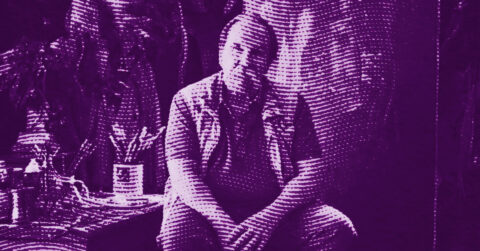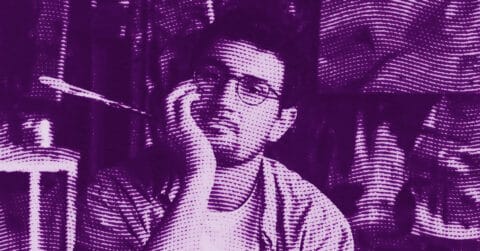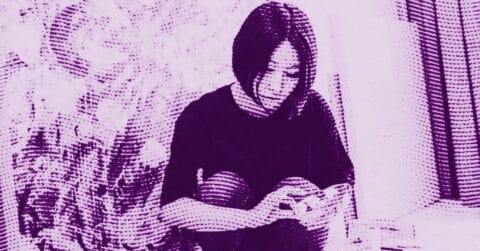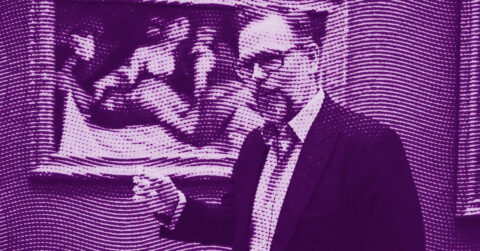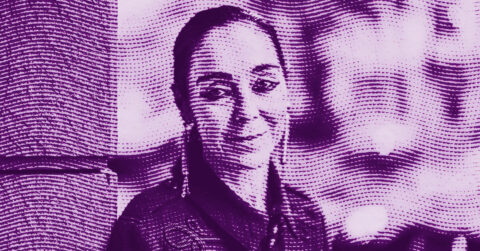Listen to me carefully, you bunch of snobs. Here is a man who paints with his fingers and has managed to shake the dusty foundations of the contemporary art market. Thomas Amoako Boafo, born in Accra in 1984, does not merely represent black bodies. He sculpts them in paint, caressing them with his fingertips until they vibrate with an electric presence that challenges us, confronts us, forces us to truly look.
In this era where contemporary African art is finally receiving the attention it deserves, Boafo is not just riding a wave. He creates his own tsunami. His monumental portraits, these living paintings that look at us with disturbing intensity, constitute much more than a simple celebration of black beauty. They form a visual manifesto that redefines the codes of contemporary portraiture and questions our relationship with otherness [1].
Boafo’s technique is not a gimmick. When he abandons the brush to knead oil paint directly with his fingers, tracing those sensual swirls of cobalt blue and burnt ochre that bring the faces and bodies of his models to life, he performs a profoundly political act. This tactile, almost sculptural approach transforms the act of painting into a caress, a physical recognition of the humanity of his subjects.
Born in the Osu district of Accra, Boafo grew up in a Ghana where art was not considered a viable career. After graduating from the Ghanatta College of Art and Design in 2008, named the best portraitist of his class, he tried his hand as a semi-professional tennis player before moving to Vienna in 2013 to continue his studies at the Academy of Fine Arts. It was in this imperial city, confronted with the marginalization of black people in Austria, that he found his artistic path.
The influence of Egon Schiele on Boafo’s work is undeniable but transcends mere stylistic citation. Where Schiele explored the existential angst of the Viennese bourgeoisie of the early 20th century, Boafo seizes this expressionist tradition to affirm the dignity and beauty of bodies too long made invisible by Western art. His self-portraits, in particular, defy the stereotypes of black masculinity with an assumed vulnerability reminiscent of the tormented nudes of the Austrian master.
The Architecture of Intimacy
The exhibition “I Do Not Come to You by Chance” that just ended at the Gagosian Gallery in London (April 10 to May 24, 2025) reveals a new dimension of Boafo’s practice. In collaboration with architect Glenn DeRoche, the artist recreated the courtyard of his childhood home in Accra, transforming the gallery space into an immersive environment. This installation is not merely picturesque. It constitutes an architectural reflection on the notion of community and collective learning that characterizes Ghanaian culture.
Traditional African architecture, particularly the spatial organization around the central courtyard, functions according to principles radically different from Western individualism. In colonial and then postcolonial urbanism, these community spaces were often neglected or destroyed in favor of European models. By recreating this courtyard in one of London’s most prestigious galleries, Boafo performs a powerful symbolic reversal.
This approach is part of a lineage of contemporary artists who question the museum space and the gallery as a place of power. But unlike the institutional critique strategies developed in the 1970s, Boafo does not seek to denounce. He proposes, he affirms, he imposes his vision of social space. The courtyard becomes a metaphor for the workshop, the place of exchange and transmission of knowledge.
The architecture of this installation dialogues with the exhibited works according to a logic that goes beyond simple scenography. The artist’s self-portraits, notably “Self-Portrait with Cacti” (2024), this canvas more than four meters long that shows him lying in his bed surrounded by lush plants, take on a new dimension in this context. Domestic intimacy reveals itself as a political space, a territory of resistance against identity assignments.
The use of floral wallpaper in several works is not trivial. These patterns, of European origin, recall the colonial history and the complex cultural exchanges between Africa and Europe. Boafo does not reject them but integrates them into his plastic vocabulary, creating a visual synthesis that reflects his own transnational experience. Architecture thus becomes in Boafo a political as well as aesthetic language. His spaces, whether his Ghanaian studios or his temporary installations, function as counter-proposals to the dominant spatial order. They assert ways of being and living together that resist the individualistic logics of the contemporary art market.
This architectural dimension of his work finds its most accomplished expression in the dot.ateliers project, launched in 2022 in Accra. More than just an artist residency, this space designed by David Adjaye constitutes a true alternative to the Western cultural infrastructure. By creating an autonomous artistic ecosystem in Africa, Boafo short-circuits the traditional circuits of artistic legitimization that pass through European and American capitals.
The Sociology of the Gaze
Boafo’s work fundamentally questions the social construction of the gaze and the mechanisms of mutual recognition. His portraits do not merely represent black individuals. They analyze and deconstruct the modalities of social visibility in our contemporary societies.
Sociology teaches us that the act of seeing is never neutral. It is inscribed in power relations, social hierarchies, value systems that determine what deserves to be looked at and how. Boafo’s portraits function as devices for reversing this social gaze. His models, often from his personal circle or the African art scene, stare at us with a quiet assurance that reverses the traditional relations of visual domination.
This strategy recalls W.E.B. Du Bois’ analyses of the “double consciousness” of the African-American experience, this ability to see oneself simultaneously from within and from the point of view of the dominant group. Boafo, who titled one of his major exhibitions “Soul of Black Folks” in direct reference to the sociologist [2], transforms this double consciousness into a creative force. His self-portraits, in particular, explore this tension between the intimate and the political with remarkable acuity.
The sociological analysis of Boafo’s work also reveals its performative dimension. By painting mainly black subjects in poses of confidence and majesty, the artist does not merely document a social reality. He fabricates it, he stages it, he makes it visible where it was denied or concealed. This performative dimension is part of a tradition of African-American art that goes from Jacob Lawrence to Kehinde Wiley, but Boafo brings his specifically African perspective to it.
The question of social class discreetly but constantly traverses Boafo’s work. Born into a modest family, the son of a fisherman and a cook, he knew precarity before gaining international recognition. This experience is reflected in the choice of his models and in the way he represents them. Far from the sometimes flashy glamour of certain contemporary portraitists, Boafo cultivates a form of casual elegance that transcends class barriers.
His portraits of artist friends, family members, or personalities he admires create a gallery of portraits of the contemporary black creative bourgeoisie. But this emerging cultural elite is never represented complacently. Elegant clothes, sophisticated poses, colorful backgrounds function as signs of social success but also as masks that can hide deeper fragilities.
The sociological dimension of Boafo’s work finds its most evident translation in his community engagement. The dot.ateliers constitute not only an artistic project but a true social laboratory. By offering free workspaces to young Ghanaian artists, by organizing residency programs for writers and curators, Boafo creates the conditions for the emergence of a new generation of African intellectuals and creators.
This approach openly opposes the neoliberal logics that dominate the contemporary art market. Where the Western system favors individual competition and the accumulation of symbolic capital, Boafo proposes a collaborative and community model. This philosophy is also reflected in his artistic practice, where painting becomes a gesture of recognition and celebration of the other.
The sociological impact of Boafo’s work far exceeds the artistic field. By imposing a new aesthetic of black representation, by creating alternative institutions, by refusing certain speculative logics of the art market, he contributes to redefining the power relations in the global cultural ecosystem [3]. His commercial success, culminating with the sale of “Hands Up” for 3.4 million dollars at Christie’s in 2021, demonstrates that this alternative can be economically viable.
Yet, Boafo seems aware of the dangers that this success represents. In his recent statements, he expresses his desire to slow down the pace of exhibitions to devote himself to other projects, notably the creation of a tennis academy and the development of his architectural initiatives. This desire for diversification reveals a fine understanding of the mechanisms of recuperation that threaten any subversive artistic practice.
The partnership with Dior in 2021, the first collaboration between the French house and an African artist, perfectly illustrates this tension. On the one hand, this alliance offers Boafo international visibility and considerable financial resources. On the other hand, it exposes him to criticism of commercial recuperation and dilution of his political message. The artist seems to navigate these troubled waters with remarkable tactical intelligence, using the resources of the system to finance his alternative projects.
The Creative Ecosystem
Boafo’s ambition far exceeds the creation of individual works. With the dot.ateliers, he is building a true creative ecosystem that functions according to principles radically different from the Western cultural infrastructure. This systemic approach reveals a sophisticated understanding of the contemporary challenges of artistic creation.
The space designed by David Adjaye in Accra constitutes not only a place of artistic production. It functions as a social laboratory where new forms of creative collaboration are tested. The library, the café, the studios, the exhibition gallery create an environment conducive to chance encounters and unexpected collaborations. This architecture of serendipity opposes the logics of profitability and optimization that characterize most contemporary cultural institutions.
The residency program for writers and curators, launched in 2024 with dot.ateliers | Ogbojo, testifies to this desire to create bridges between disciplines. By welcoming theorists and critics alongside plastic artists, Boafo recognizes the importance of discourse and theoretical reflection in the emergence of new aesthetics. This holistic approach to artistic creation recalls the great historical avant-gardes that combined artistic practice and intellectual reflection.
The impact of these initiatives is already being measured in the emergence of a new generation of Ghanaian and West African artists who are beginning to gain international recognition. Artists like Otis Kwame Kye Quaicoe, a childhood friend of Boafo who now exhibits at Roberts Projects in Los Angeles, benefit from this collective dynamic. This group development strategy opposes the individualistic logics that usually dominate the art market.
The economic dimension of this project is particularly interesting. By creating a viable artistic ecosystem in Africa, Boafo bypasses the traditional mechanisms of value extraction that characterize the relationships between creative peripheries and the centers of the art market. Artists trained in his workshops no longer need to exile themselves to Western metropolises to gain recognition. They can develop their practice locally while benefiting from international visibility.
This approach is part of a broader reflection on the decolonization of cultural institutions. But unlike purely critical discourses that denounce without proposing alternatives, Boafo concretely builds the tools of another cultural globalization. His workshops function as prototypes of post-colonial institutions that respect local specificities while being part of global networks.
The Alchemy of the Finger
Boafo’s pictorial technique deserves to be examined as it constitutes the most immediately recognizable element of his style. But this aesthetic signature should not hide the conceptual sophistication that underlies this approach. Abandoning the brush to directly knead paint with his fingers, Boafo reconnects with a primitive gesture that evokes the first artistic expressions of humanity. This apparent regression to an archaic stage of creation actually conceals an elaborate conceptual strategy. By painting the skin of his models with his own fingers, the artist establishes a mediated physical contact that transforms the act of representation into a caress.
This tactile dimension of painting is not without recalling the analyses developed by the anthropology of art on cultures where plastic creation is accompanied by specific bodily rituals. In many African traditions, the making of artistic objects involves direct contact between the artist’s body and the worked material. Boafo reactivates this ritual dimension of creation while inscribing it in the context of contemporary Western art.
The visual effects obtained by this technique far exceed the anecdote. The swirls of paint traced with the finger create textural effects that give the faces and bodies a striking physical presence. This materiality of the paint resonates with the contemporary obsession with surfaces and screens. In a world where images are dematerializing, Boafo claims the thickness and sensuality of the pictorial material.
The chromatic palette used by the artist reveals sophisticated colorist research. The browns, ochres, cobalt blues, and purples that make up the flesh of his models escape realistic conventions to explore all the richness of the possible tones of black skin. This chromatic freedom is part of a pictorial tradition that goes from Gauguin to the Fauves, but Boafo applies it specifically to the representation of black bodies, creating an unprecedented colorist vocabulary.
The use of photographic transfer for clothing and backgrounds creates a technical contrast that enriches the reading of the works. This heterogeneity of processes reveals a postmodern approach to painting that embraces the hybridization of mediums. Boafo does not seek technical purity but expressive effectiveness, even if it means mixing the most diverse approaches.
The sculptural dimension of his portraits, often highlighted by commentators, deserves to be analyzed more finely. The impastos created by finger painting do indeed give the faces a relief that evokes sculpture. But this three-dimensionality remains purely pictorial. It creates the illusion of volume without ever truly crossing the border that separates painting from sculpture. This generic ambiguity enriches the conceptual complexity of the works.
The speed of execution imposed by the finger technique also influences the overall aesthetics of the portraits. Boafo cannot go back over his gestures, correct, or repent. This technical constraint generates a form of controlled spontaneity that gives the faces their expressive intensity. The artist must capture the essence of his model in the instantaneity of the pictorial gesture, which gives his portraits a particular vitality.
This gestural approach is part of a lineage with American abstract expressionism, particularly with Jackson Pollock’s action painting. But where Pollock evacuated figuration in favor of pure gesture, Boafo reconciles bodily performance and representation. He proves that it is possible to combine technical radicality and iconographic accessibility.
The assumed influence of Egon Schiele in this approach reveals a fine understanding of Western art history [4]. Boafo does not copy the formal solutions of the Viennese master but is inspired by his expressive approach to figuration. He translates into his own plastic language the lesson of psychological intensity that Schiele’s art delivers, while applying it to radically different subjects.
Self-portraits occupy a singular place in this technical economy. When Boafo paints himself with his fingers, he performs a gesture of self-caress that gives these works a subtle autoerotic dimension. This assumed sensuality opposes the traditional representations of black masculinity, often confined to the registers of strength or threat. The artist reveals the vulnerability and beauty of the black male body with an audacity that commands admiration.
This finger technique also functions as a commercial signature in a contemporary art market obsessed with the immediate recognition of styles. An amateur can identify a Boafo at first glance, which constitutes a decisive advantage in the economy of attention that characterizes our era. But this ease of identification should not hide the conceptual complexity that underlies this technical approach.
Art as Resistance
Beyond its undeniable aesthetic qualities, Boafo’s work functions as a political act of resistance to contemporary forms of cultural domination. This subversive dimension is not expressed in an explicitly militant discourse but in the simple affirmation of black beauty and dignity.
In a world where images of black bodies are still too often associated with suffering, violence, or exoticism, Boafo offers a radical aesthetic alternative. His models pose with a quiet assurance that defies stereotypes. They look at us as equals, without asking for permission or recognition. This evidence of black beauty constitutes in itself a powerful political gesture.
The artist accomplishes this aesthetic revolution without falling into the traps of message art. His portraits escape propaganda as well as complacency. They impose themselves first by their plastic force before delivering their political charge. This strategy of aesthetic seduction reveals a fine understanding of the mechanisms of reception of contemporary art.
The collaboration with Jeff Bezos to adorn a Blue Origin rocket with three of his works perfectly illustrates this ability to infiltrate the most unexpected spaces of power. By sending portraits of his mother, himself, and the mother of an artist friend into space, Boafo accomplishes a symbolic gesture of considerable scope. These black bodies that travel to the stars reverse the traditional narratives of spatial exploration, a domain historically reserved for white Western elites.
This strategy of infiltration rather than frontal opposition characterizes Boafo’s entire political approach. Rather than denouncing the mechanisms of exclusion in the art world, he circumvents them by creating his own institutions. Rather than criticizing the commodification of art, he uses his commercial successes to finance alternative projects.
The refusal of certain miraculous contracts, notably that famous million-dollar agreement that he declined in 2019, testifies to a conception of art that is not reduced to the accumulation of capital. This ethic of measure contrasts with the often excessive appetite of contemporary artists for recognition and money.
Boafo’s commitment to the development of the Ghanaian art scene is part of this logic of constructive resistance. By training a new generation of African artists, by creating autonomous cultural infrastructures, he contributes to rebalancing the power relations in the global artistic ecosystem.
This political approach to art does not burden itself with explicit theoretical references. Boafo does not quote Frantz Fanon or Édouard Glissant in his public statements. His politics are expressed in concrete action rather than in discourse. This pragmatic effectiveness reveals a political maturity that goes beyond surface militant postures.
Boafo’s international success demonstrates that it is possible to combine artistic ambition and political commitment without sacrificing one to the other. His exhibitions in the most prestigious Western galleries do not prevent him from maintaining his African roots. This ability to navigate between several worlds without betraying himself constitutes one of the most precious lessons of his journey.
This is why Amoako Boafo is one of the most essential artists of our time. Not only for the beauty of his portraits or the originality of his technique, but for his ability to transform art into a tool for social transformation. In a world in crisis, his works remind us that beauty can be an act of resistance and that art remains one of our last spaces of authentic freedom.
While the contemporary art market sometimes seems to be reduced to a simple casino for bored billionaires, Boafo proves to us that it is still possible to make art a vector of collective emancipation. This is perhaps his greatest achievement: having been able to preserve utopia in the very heart of the system that tends to destroy it. A tour de force that deserves our sustained respect and attention.
- Gagosian Gallery, artist profile Amoako Boafo, 2025.
- Denver Art Museum, “Soul of Black Folks: Amoako Boafo Guide”, 2023.
- Contemporary Arts Museum Houston, exhibition documentation “Soul of Black Folks”, 2022.
- Belvedere Museum Vienna, exhibition catalog “Proper Love”, 2024.


